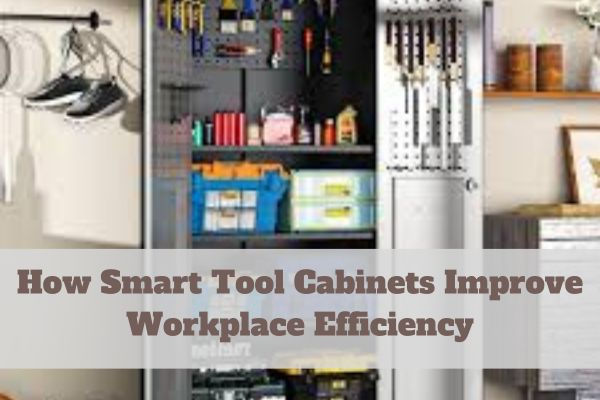How Smart Tool Cabinets Improve Workplace Efficiency
- toolcabinetsol
- Mar 26
- 3 min read

Smart tool cabinet an innovative storage solution designed to streamline tool organization, enhance security, and optimize operations. In modern workplaces, efficiency is the key to productivity and reducing costs. Businesses, especially in manufacturing, construction, and maintenance, rely heavily on tools and equipment. However, tool mismanagement often leads to wasted time, lost tools, and increased expenses.
This article explores how a smart tool cabinet improves workplace efficiency and why industries should consider integrating this.
The Role of Smart Tool Cabinets in Workplace Efficiency
A smart tool cabinet is more than just a storage unit; it is an intelligent system that uses RFID, IoT, and AI-driven technology to monitor, track, and manage tools effectively. Here are some key ways in which smart cabinets contribute to workplace efficiency:
1. Enhanced Organization and Accessibility
Traditional tool storage often leads to disorganization, making it difficult to find the right tools when needed. A smart tool cabinet categorizes tools systematically, ensuring that employees can easily locate and access them. With features like digital inventory tracking and automated logging, workers spend less time searching for tools and more time working productively.
2. Minimization of Tool Loss and Theft
Tool misplacement and theft are significant challenges in industrial settings. A smart cabinet integrates access control systems such as biometric authentication, RFID tracking, and surveillance, ensuring that only authorized personnel can retrieve tools. Additionally, the system logs every transaction, reducing the chances of tool mismanagement and unauthorized use.
3. Real-Time Inventory Management
One of the most impactful benefits of a smart tool cabinet is real-time inventory tracking. Traditional methods rely on manual checks, which are time-consuming and prone to errors. With IoT-enabled smart cabinets, businesses can monitor tool availability, receive alerts when stocks are low, and automate reordering processes. This ensures seamless operations without unexpected disruptions due to missing equipment.
4. Automated Check-In and Check-Out System
A smart cabinet streamlines the check-in and check-out process by recording who accessed which tool and when. This feature is particularly useful for businesses that operate in shifts, as it provides full visibility of tool usage and availability. Employees can quickly retrieve tools, eliminating long wait times and boosting workflow efficiency.
5. Reduction in Downtime and Maintenance Costs
Unexpected tool failures can lead to significant downtime, disrupting workflow and impacting productivity. A smart tool cabinet helps prevent such issues by tracking the condition and usage of tools. Predictive maintenance alerts businesses about tools requiring servicing or replacement, minimizing equipment failure and ensuring a smooth operational flow.
Industry-Specific Benefits of Smart Tool Cabinets
Different industries benefit uniquely from smart cabinets, making them an essential investment for various business sectors.
1. Manufacturing and Industrial Sectors
In manufacturing facilities, efficiency is crucial for meeting production deadlines. A smart tool cabinet ensures that assembly line workers have immediate access to the tools they need, improving workflow and minimizing disruptions. Real-time inventory tracking also prevents tool shortages and reduces unnecessary procurement costs.
2. Construction and Engineering
The construction industry relies on a vast array of tools for different tasks. Misplaced or stolen tools can delay projects and increase costs. Smart cabinets provide secure storage and tracking, ensuring that construction workers have the right tools at the right time, thus enhancing project efficiency.
3. Automotive and Aerospace
Precision is critical in automotive and aerospace industries. A smart tool cabinet ensures that specialized tools are available when needed, reducing errors and improving quality control. Moreover, automated tracking helps meet industry compliance standards.
4. Healthcare and Laboratories
In hospitals and research labs, accurate tool and equipment management is essential. A smart cabinet ensures that medical instruments are stored securely and are easily accessible when required, improving patient care and research efficiency.
Wholesale Smart Tool Cabinets: A Cost-Effective Investment
For businesses looking to equip multiple workstations with smart storage solutions, wholesale tool cabinets are an excellent option. Purchasing in bulk offers cost savings and ensures uniformity across different locations. Many suppliers offer customizable options to suit industry-specific needs, making wholesale purchases a strategic move for large organizations.
Future Trends in Smart Tool Cabinet Technology
With continuous advancements in smart technology, smart cabinets are becoming more sophisticated. Future trends include:
AI and Machine Learning Integration: AI-driven analytics to predict tool usage patterns and optimize inventory management.
Cloud Connectivity: Enhanced cloud-based storage solutions for remote monitoring and management.
Blockchain for Security: Blockchain technology to secure transaction logs and prevent unauthorized access.
Voice-Controlled Access: Hands-free access through voice recognition technology.
Conclusion
A smart tool cabinet is a game-changer for businesses aiming to improve workplace efficiency. By enhancing organization, preventing tool loss, enabling real-time inventory tracking, and reducing downtime, smart cabinets provide a high return on investment. Whether in manufacturing, construction, automotive, or healthcare industries, integrating a smart cabinet optimizes workflow and enhances productivity.
For businesses considering large-scale implementation, investing in wholesale tool cabinets ensures cost savings and operational consistency. As technology evolves, smart cabinets will continue to play a pivotal role in modern workplaces, driving efficiency and innovation.




Comments